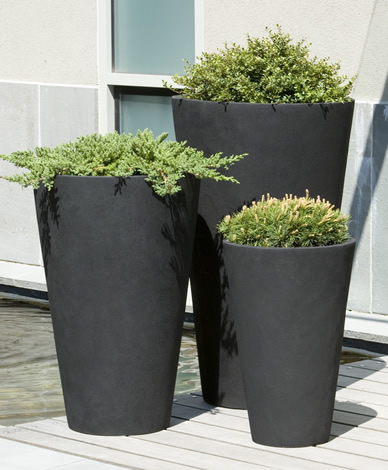Notes from the Garden: Tips on Pots, Urns and Planters

Pots, urns and window boxes are a fun and easy way to add color while providing the flexibility to experiment with new plants, colors and textures.
Before planting begins, be sure to fill the bottom of the container with a 2-inch layer of crushed Perlite to ensure the plants have proper drainage. Styrofoam packing material or gravel can also be used as suitable alternatives. Next, add moistened soil-less potting mixture on top of the Perlite or packing material, leaving about 1 ½ inches between this layer and the rim of the planter. Pots and urns can damage wooden decks and stain concrete patio surfaces when water leaks and condensation builds underneath the pot. Prevent this potential water damage by using saucers under your containers.
Different combinations can be used in the planters, including shrubs, grasses, tree-form flowers and vines, perennial and annual flowers, herbs and vegetables, and many others. Herbs and vegetables tend to thrive in containers, require little care, and are as attractive as they are useful. Most herbs flower at least once during the season, making them colorful choices for containers. Basil and rosemary are good for containers because they like for the soil to dry out in between waterings. Different varieties of basil offer an eye-pleasing range of colors and textures. If basil is regularly pinched back it will bush outward and spill over, cascading down the sides of the container. Rosemary’s light blue flowers make it a great trailing plant.
Surround a single shrub or tree-form flower with vibrant annual flowers or green vines to create a lasting container planting. Plant a slow-growing shrub as a permanent fixture, such as boxwood, and then include colorful annual flowers around it along with vines such as English ivy. The enchantment of the annual flowers will only last one season, but the boxwood and English ivy will last for years to come. Try planting different flowers every year for a fresh new look. You can also try different shapes of shrubs or tropical plants to achieve more movement in your display.
Combining long lasting color and wonderful textures makes for a fabulous display. Form and foliage can be beautifully combined by planting flowers such as scented geraniums, lantana, lavender, snow-in summers, sunrose. Also try certain varieties of roses such as Knockout Pink roses, or Meidland roses which blend well with colorful annual flowers. These are also available in tree-topiary form.
Keep your flowers blooming by regularly watering and fertilizing, removing faded flowers or yellowing leaves and replace annuals after they finish flowering. Since pots, urns, and window boxes are more exposed to the air, their soil will dry out quicker than soil in the ground. Be sure to water by touch, and not by sight. To test this, push your finger about one inch into your container’s potting mix and if it feels dry, it is time to water. Not only do plants in containers need more constant watering, but they will also need more fertilizer as the requent watering leaches out plant nutrients. Plants in containers will benefit most from a regular feeding program.
There are so many plants, so many combinations, and so many ideas to grow a healthy container garden and provide you with a boost of garden esteem.
Landscape Designer, writer and lecturer Frederico Azevedo is the founder of Unlimited Earth Care, Inc., providing landscape design and maintenance to the Hamptons for over 20 years. For more information; call (631)725-7551 or visit unlimitedearthcare.com.









